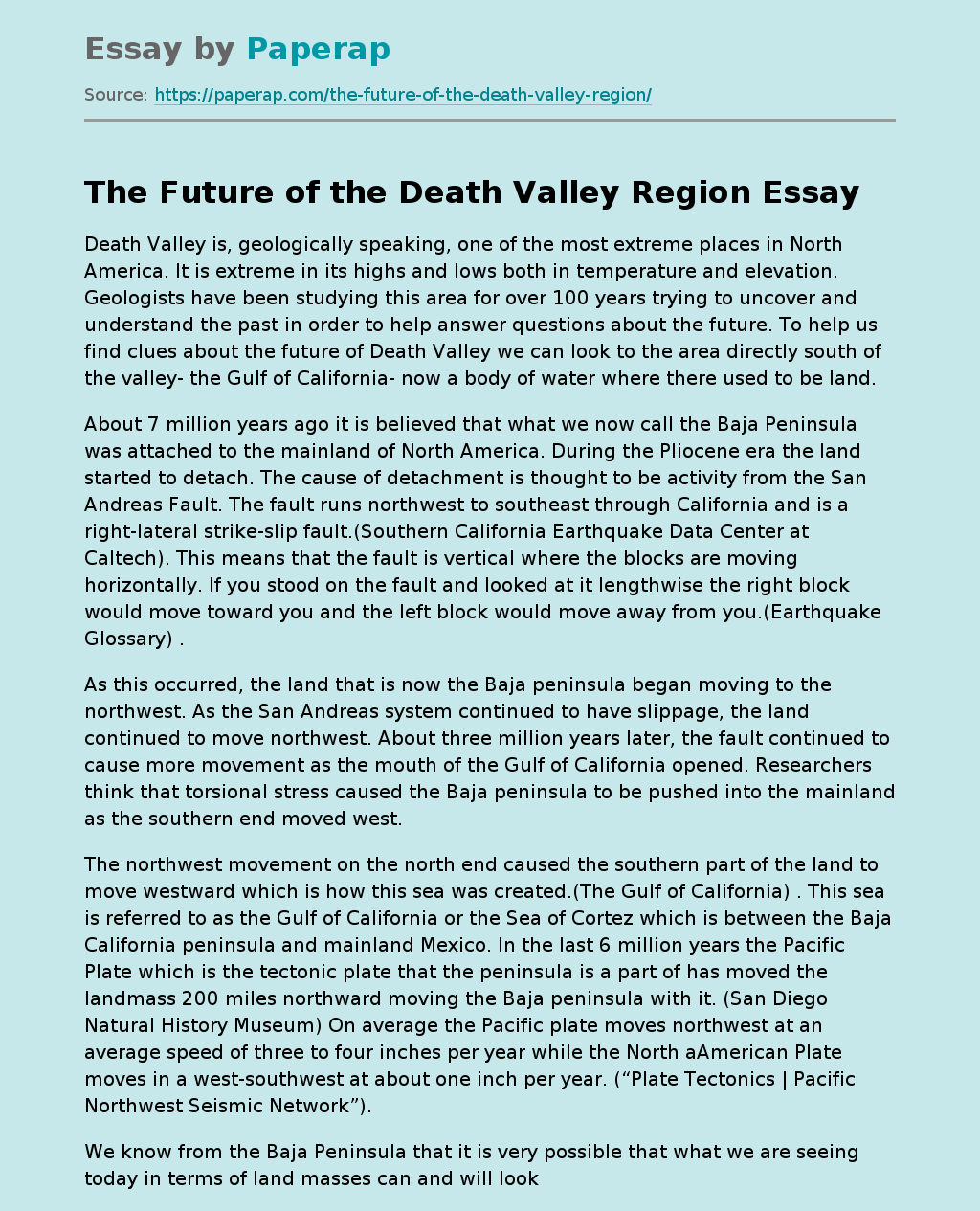The Future of the Death Valley Region
Death Valley is, geologically speaking, one of the most extreme places in North America. It is extreme in its highs and lows both in temperature and elevation. Geologists have been studying this area for over 100 years trying to uncover and understand the past in order to help answer questions about the future. To help us find clues about the future of Death Valley we can look to the area directly south of the valley- the Gulf of California- now a body of water where there used to be land.
About 7 million years ago it is believed that what we now call the Baja Peninsula was attached to the mainland of North America. During the Pliocene era the land started to detach. The cause of detachment is thought to be activity from the San Andreas Fault. The fault runs northwest to southeast through California and is a right-lateral strike-slip fault. This means that the fault is vertical where the blocks are moving horizontally.
If you stood on the fault and looked at it lengthwise the right block would move toward you and the left block would move away from you.
As this occurred, the land that is now the Baja peninsula began moving to the northwest. As the San Andreas system continued to have slippage, the land continued to move northwest. About three million years later, the fault continued to cause more movement as the mouth of the Gulf of California opened. Researchers think that torsional stress caused the Baja peninsula to be pushed into the mainland as the southern end moved west.
The northwest movement on the north end caused the southern part of the land to move westward which is how this sea was created. This sea is referred to as the Gulf of California or the Sea of Cortez which is between the Baja California peninsula and mainland Mexico. In the last 6 million years the Pacific Plate which is the tectonic plate that the peninsula is a part of has moved the landmass 200 miles northward moving the Baja peninsula with it. On average the Pacific plate moves northwest at an average speed of three to four inches per year while the North aAmerican Plate moves in a west-southwest at about one inch per year.
We know from the Baja Peninsula that it is very possible that what we are seeing today in terms of land masses can and will look vastly different millions of years from now thanks to the geologic wonders of the world. Death Valley lies on the same fault that created the Baja Peninsula. It was formed from a pull apart-fault. The land has dropped along the fault lines causing the region to widen. Blocks being down dropped and upraised blocks are found all over Nevada and Utah creating a Basin and Range Region. Death Valley is getting wider due to the way the faults are angled and the dropping blocks. Scientists have begun using sophisticated GPS, using this technology they can see that the valley is widening at about two to three inches per year.
The process is very slow but if you compound that over millions of years it becomes significant. It is believed that if the spreading continues -and it will- and the Baja Peninsula continues its course in the northwest direction that eventually the Gulf of California could extend up into Death Valley. Something that could be significant is the fact that there is a volcanic ridge that runs down the middle of the gulf. Lava leaks up and moves away slowly as the new lava continues to flow and push it out. Death Valley also has lava that leaks along it’s fault lines and is recently active with eruptions that have occurred over the past 200 to 300 years.
California spans two tectonic plates. The San Andreas Fault is the plate boundary where the most south westerly part of the state is on the Pacific Plate while the rest of the state is on the North American Plate. If the pattern continues where the North American Plate continues on it’s southwestern track and the Pacific Plate continues moving northwest it isn’t inconceivable that millions of years from now that most of California could be part of the Pacific Plate. This could mean that Los Angeles would move northwest until it is adjacent to San Francisco. However, there are researchers that claim that the San Andreas Fault has become “hung up” near the town of Frasier Park, California.
They have noticed that the fault is out of alignment. This has caused some geologists to hypothesize that it will have to release the strain somewhere else. They believe that a zone of instability known as Walker-Lane might be just the place. By using GPS they have found that only 75% of the movement between the two plates is happening on the San Andreas Fault. The other 25% is moving up the Eastern Sierra headed towards Reno where Walker-Lane is located. This would back up the idea that the Gulf of California will one day stretch all the way north to Reno, Nevada with much of the desert turning into ocean floor.
While none of us know the future or what it holds, it is fascinating to think that millions of years from now the landscape we know will be totally different. The geologic activity in the Death Valley region will undoubtedly change the landscape there and with new areas of instability forming those changes may not be anything we could have imagined. As technology improves, I imagine future geologists will have a clearer picture of what could happen in the future but millions of years is a long time and we just don’t know what mother nature has up her sleeve.
The Future of the Death Valley Region. (2021, Dec 15). Retrieved from https://paperap.com/the-future-of-the-death-valley-region/

